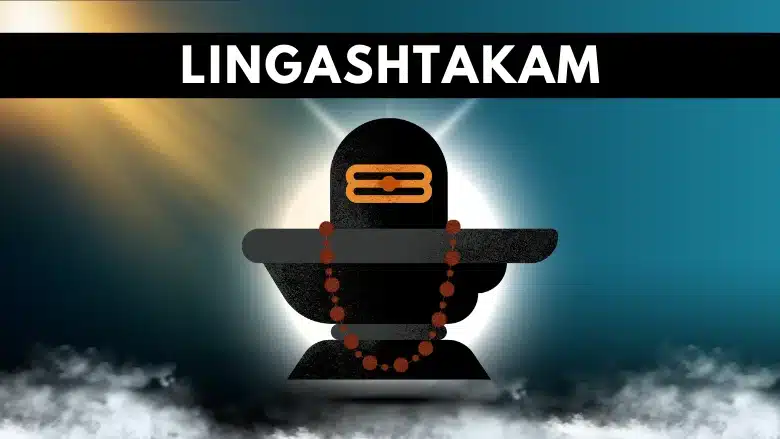Lingashtakam, is a hindu devotional song that praise Lord Shiva in Sanskrit, set in his most-loved raga, Shivaranjini. There are many ashtakams in Hinduism. This is an ancient poetic style comprising 8 verses composed by rishis of the past. Lingashtakam is one of the most heard in many sacred temples. You might have heard this sloka the most on Shivarathri and any day that needs Lord Shiva’s attention. This blog delve into Lingashtakam lyrics it’s meaning and significance.
Lingashtakam Tales
I always feel the stories and significance of a sloka make it more interesting to learn it – Don’t you agree? The stories behind Lingashtakam stotram make it a cherished piece in the collection of Hindu devotional songs.
Legends say, many centuries ago, Lord Brahma, the creator, and Lord Vishnu, the preserver, had a huge argument over who is better. Lord Shiva comes to intervene and manifests himself as a beam of light in front of them. He asks each of them to go in opposite directions to find the beginning and end of the light. Lord Vishnu takes the form of a pig (Koorma Avatar) and starts digging the earth, while Lord Brahma takes the form of a Swan, flying upward, both following the light.
Many years pass by and while Lord Brahma is getting impatient, he finds a fragrant screw pine or Ketaki flower falling down. He asks the flower where she was coming from to get a rough idea of how far the light could go. The flower says it has been falling down from Lord Shiva’s head for centuries together.
Lord Brahma is taken aback and plots a plan with her to lie to Lord Shiva that he found the beginning of the light rays and the flower was his witness. Hesitantly the flower agrees and goes to Lord Shiva to claim his win. In the meanwhile, Lord Vishnu’s pig nose starts to bleed and He goes to Lord Shiva accepting his defeat stating no one could find the beginning and end of the universe.
The all knowing Shiva blesses Vishnu for his honesty. He turns to the flower and Lord Brahma, roars to the entire universe that he should not be worshipped and the flower should not enter his temple again. He also cursed the flower to grow amongst snakes, making it dangerous to harvest despite its profound beauty and its aromatic scent. The flower goes to all the gods and finally goes to his wife, Shakthi, who accepts her with open arms.
With the intervention of Lord Vishnu’s compelling arguments, Shiva agrees to forgive Brahma but a curse once given cannot be taken back. This is when, both of them start to praise Lord Shiva for his justice, that we celebrate as Shivarathri, and Lingashtakam reverberates in the entire universe with Brahma and Vishnu in the pooja’s forefront.
There are other references in the Hindu puranas where Ravana’s pride is burnt to ashes when he attempted to uplift Mount Kailash after getting the boon of being indestructible from Lord Shiva himself.
Lingashtakam in Sanskrit was also chanted duringin Dakshan’s Yagnya. Shakthi marries Shiva after following severe penances despite her father’s (King Dakshan) wishes. In a fit of revenge, he does not invite Lord Shiva alone for his sacred function which enrages Sati and she self-immolates in the Yagnya fire. It is said that Shakthi was given back to Shiva by Agni, the lord of fire, and this stotram was chanted to depict the sadness and calm Him down.
Significance of Lingashtakkam
The Lingashtakam meaning lies in its ability to invoke devotion and surrender. I have had gurus asking me to chant Lingashtakam in front of the Shiva Linga represents Lord Shiva and Shakthi in a phallic symbol on top that joins the feminine half shaped like a yoni which is said to be the eternal dance of these two deities around the universe.
We were asked to take a shower and chant this while performing a Shiva pooja with flowers, milk, water, honey or whatever you can, with utmost Bhakthi (devotion) to gain the blessings of this iconic god of Hinduism.
It is said that chanting Lingashtakam calms Lord Shiva who blesses your life with abundance and is a devotee’s declaration of being truthful, loyal, obedient and devoted to HIM.
Lingashtakkam Raga: Shivaranjini
In Hindustani classical music, the mystical Shivaranjini appears in Khafi thaat while in Carnatic, it is considered as the janya or the derivation of the 66th Melakartha scale, Kharagharapriya. The ascending and descending swaras of this raga are as follows:
Aarohanam : s r2 g2 p d2 S
Avarohanam : S d2 p g2 r2 s
Note that the lowest Shadjam is represented as ‘s’ and the highest as ‘S’. The other notes include Chathushruthi Rishabam, Sadharana Gandharam, Panchamam, and Chathushruthi Daivatham. This renowned raga is said to be one of Lord Shiva’s favourites and it is said to please Him.
Lingashtakam Composer: Adi Shankaracharya
No one knows when Lingashtakam was composed but some scholars confirm that the writing style of the 8th century poet and philosopher, Adi Shankaracharya, resembles the way the sloka is drafted as it is similar to Phalasruti of Shiva Panchakshari.
Other popular opinions agree that Mahamuni Agastiyar, who is also an ardent devotee of the lord, could have composed this evergreen masterpiece.
Lingashtakam Lyrics (In English with meaning)
The Lingashtakam lyrics beautifully blend poetic grandeur with devotion. Here is an excerpt
Brahma Muraari Suraarchita Lingam
Nirmala Bhashita Shobhita Lingam
Janmaja Dukha Vinaashaka Lingam
Tat Pranamaami Sadaa Shiva Lingam
The first verse talks about the most loved Lingham, adored by Lord Brahma, Lord Vishnu and the celestial bodies, and the poet saluting this immortal lingham shining with purity to demolish the sorrows of this human birth. These timeless lines are available in multiple languages, including Lingashtakam in English, Tamil, and Telugu, making it accessible to devotees worldwide.
Devamuni Pravaraarchita Lingam
Kaamadaham Karunaakara Lingam
Raavana Darpa Vinaashaka Lingam
Tat Pranamaami Sada Shiva Lingam
The second verse continues to praise the Shiva Lingham, worshipped by gods and sages that burns all desires with compassion, just like how it destroyed Ravana’s pride of being immortal into ashes.
Sarva Sugandha Sulepitha Lingam
Buddhi Vivardhana Kaarana Lingam
Siddha Suraasura Vanditha Lingam
Tat Pranamaami Sadaa Shiva Lingam
The third verse describes Shivalingam’s eternal beauty covered in sacred fragrances like sandalwood and ash, that improves one’s cosmic intelligence with better judgement worshipped by the hermits, devas and asuras.
Kanaka Mahaamani Bhushitha Lingam
Phanipathi Veshtitha Shobhitha Lingam
Daksha Suyajna Vinaashaka Lingam
Tat Pranamaami Sadaa Shiva Lingam
The fourth verse talks about how the lingham is embellished with gold and rare gems attached to the serpent that is constantly around Lord Shiva’s neck that destroyed Dakshan’s sacrificial ritual and represents the ego that you need to wear in your neck without it affecting you.
Kumkuma Chandana Lepitha Lingam
Pankaja Haara Sushobhitha Lingam
Sanchitha Paapa Vinaashaka Lingam
Tat Pranamaami Sadaa Shiva Lingam
The fifth verse describes the kumkumam (sacred crimson powder) and sandalwood paste with fully-bloomed lotus garlands that the lingham adorns. Witnessing this beautiful scene is said to destroy one’s past sins that are a gateway to salvation.
Devaganaarchitha Sevitha Lingam
Bhaavair Bhakti Bhirevacha Lingam
Dinakara Koti Prabhakara Lingam
Tat Pranamaami Sadaa Shiva Lingam
The sixth verse explains how the Gods beyond earth that we call devas, worship lingham with utmost devotion and understanding that is said to be equivalent to the grandeur of infinite suns.
Ashta Dalopari Veshtitha Lingam
Sarva Samudbhava Kaarana Lingam
Ashta Daridra Vinaashaka Lingam
Tat Pranamaami Sadaa Shiva Lingam
The seventh verse talks about how the Shiva Lingham is always bordered with flowers that have exactly eight petals, which is the reason behind every creation on earth. The eight petals represent the eight kinds of hardships that are destroyed when one prays to this benevolent god.
Suraguru Suravara Pujitha Lingam
Suravana Pushpa Sadaarchitha Lingam
Paraatparam Paramatmaka Lingam
Tat Pranamaami Sadaa Shiva Lingam
The eighth verse explains how Lord Shiva is the best teacher who is present in the celestial garden of Kailash and is always worshipped with fragrant flowers for being the greatest gods of all time!
Lingashtakam Idam Punyam Padeth Shiva Sannidhow
Shivalokam Avapnothi Shive Na Sahamodathe
There is a final conclusion to this sloka as the 9th verse, that marks the true significance of Lingashtakam that will open the doors of Kailash to stay with him eternally in a blissful state when told in front of a lingham.
Linghashtakam in Other Languages
As Lord Shiva is worshipped across the world, this Sanskrit stotram is transliterated in Tamil, and English for easier rendition by His devotees. Many renowned singers like S.P. Balasubramaniyan, KJ Yesudas, and Shankar Mahadevan have rendered their melodious voices to this enchanting devotional sloka.
Famous Versions of Lingashtakam
As the sloka reverberates across the globe, there are many twists to the original version we all know. Compositions by Sai Madhukar (sung by KS Chitra), S Jaykumar (performed by Sooryagayathri), Nihal (performed by Smitha), Amjad Nadeem (sung by Priyani Vani) and Jaya Kishori (performed by Jaya Kishori and Chetna Sharma) are some note-worthy renditions that are worth mentioning.
Final Thoughts
Lord Shiva’s stories are very interesting and are full of wisdom that you can follow even today. Chanting Lingashtakam on days that are auspicious to this cool deity is a blessing on its own. Chant this every day for enlightenment.
FAQs
What is Lingashtakam?
Lingashtakam is an octet hymn chanted by the people who follow Hinduism that praises Lord
Shiva.
Who wrote Lingashtakam?
There are many theories to understand the lyricist of the Lingashtakam stotram. However, some say that the 8th century philosopher, Adi Shankaracharya, drafted this sloka based on the writing style resemblance to his other sloka called Phalasruti of Shiva Panchakshari.
What is the significance of Lingashtakam?
One of the main significances of Lingashtakam is included as the 9th verse in the hymn stating that the one who chants this hymn will get Lord Shiva’s blessings in abundance that will eventually open the doors of Kailash to stay with him eternally in a blissful state.
How do you chant Lingashtakam?
Lord Shiva is known for his strict penances and his deadly temper. So, I’d advise devotees to
say it with utmost devotion and surrender to the lord while chanting this, preferably fresh out
of the shower. It is best to chant it aloud to imbibe good vibes to your space.
What are the benefits of chanting Lingashtakam?
The benefits of chanting Lingashtakam would be to get Lord Shiva’s protection and blessings from evil spirits that try to deter your determination to live the karmic life on earth. Since this sloka is composed in Sivaranjini, the favorite raga of Lord Shiva himself, it will calm your nerves making you swim in a sea of devotion.
Can anyone chant Lingashtakam?
Lord Shiva is known to be a god, who lives amidst forests roaming in danger wearing a simple deer skin to cover his bottom half and smear burnt ash on His upper body that keeps Him warm. He is also known to be extremely inclusive and pure Bhakthi reaches his heart. So, I can carefully conclude anyone can chant Lingashtakam with a pure heart and it will melt the lord for sure.
What is the best time to chant Lingashtakam?
Some say it is best to chant Lingashtakam during sunrise and sunset like any other sloka. I feel it can be told at any time of the day. There are no hard and fast rules as such.
What is the meaning of each verse in Lingashtakam?
The first verse talks about the most loved Lingham, adored by Lord Brahma, Lord Vishnu and the celestial bodies, and the poet saluting this immortal lingham shining with purity to demolish the sorrows of this human birth.
The second verse continues to praise the Shiva Lingham, worshipped by gods and sages that burns all desires with compassion, just like how it destroyed Ravana’s pride of being immortal into ashes.
The third verse describes its eternal beauty covered in sacred fragrances like sandalwoodand ash, that improves one’s cosmic intelligence with better judgement worshipped by the hermits, devas and asuras.
The fourth verse talks about how the lingham is embellished with gold and rare gems
attached to the serpent that is constantly around Lord Shiva’s neck that destroyed Dakshan’s
sacrificial ritual.
The fifth verse describes the kumkumam (sacred crimson powder) and sandalwood paste with fully-bloomed lotus garlands that the lingham adorns. Witnessing this beautiful scene is said to destroy one’s past sins that are a gateway to salvation. The sixth verse explains how the Gods beyond earth that we call devas who worship this lingham with utmost devotion and understanding that is said to be equivalent to the grandeur of a million sun rays.
The seventh verse talks about how the Shiva Lingham is always bordered with flowers that have exactly eight petals, which is the reason behind every creation on earth. The eight petals represent the eight kinds of hardships that are destroyed when one prays to the benevolent Lord Shiva.
The eighth verse explains how Lord Shiva is the best teacher who is present in the celestial garden of Kailash and always worshipped with fragrant flowers for being the greatest gods of all time!
There is a final conclusion to this sloka that marks the true significance of Lingashtakam that will open the doors of Kailash to stay with him eternally in a blissful state when told in front of a lingham.
Each verse also mention how one prostrates to Lord Shiva and is grateful to HIM
Related Blog: Nottuswaram | Shakthi Sahitha Ganapathim Lyrics































